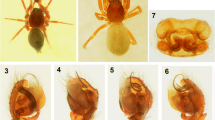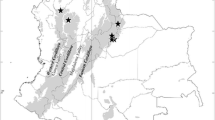Summary
Nassauvia falklandica (Compositae: Mutisieae: Nassauviinae), a new endemic herbaceous sub-shrub from the Falkland Islands, is described, illustrated and its conservation status assessed. N. falklandica is unique within the genus in possessing a row of pits towards the apex of the abaxial surface of its leaves; stomata and stiff white hairs are confined to these pits. This adaptation most likely reduces water loss in the sparsely vegetated feldmark habitats exposed to strong and drying winds in which it occurs. Its apparent restricted habitat preference contrasts in particular to the wide distribution of one of the other two Falkland endemic Nassauvia species, N. gaudichaudii. N. falklandica has an estimated world population of fewer than 250 mature individuals and is currently only known from two sites on West Falkland c. 34 km apart. Both sites are located on hill summits between 400 and 500 m altitude. The subpopulations are severely fragmented and at risk from genetic erosion, damage by livestock and stochastic events. N. falklandica is assessed as Critically Endangered B1ab(iii), B2ab(iii).



Similar content being viewed by others
References
Aldiss, D. T. & Edwards, E. J. (1999). The Geology of the Falkland Islands. British Geological Technical Report WC/99/10.
Bachman, S., Moat, J., Hill, A, de la Torre, J. & Scott, B. (2011). Supporting Red List threat assessments with GeoCAT: geospatial conservation assessment tool. ZooKeys 150: 117 – 126. doi: 10.3897/zookeys.150.2109
Broughton, D. A. & McAdam, J. H. (2005). A checklist of the native vascular flora of the Falkland Islands. J. Torrey Bot. Soc. 132 (1): 115 – 148.
Cabrera, A. L. (1971). Compositae. In: M. N. Correa (ed.), Flora Patagonica, Parte VII: 1 – 451. Instituto Nacional de Tecnologia Agropecuaria, Buenos Aires.
____ (1982). Revision del género Nassauvia (Compositae). Darwiniana 24 (1 – 4): 283 – 379.
Clapperton, C. M. & Sugden, D. E. (1976). The maximum extent of glaciers in part of West Falkland. J. Glaciology 17 (75): 73 – 77.
Cruickshank, J. G. (2001). Falkland Soils — Origins and Prospects. Report for the Department of Agriculture of Northern Ireland.
Freire, S. E., Crisci, J. V. & Katinas, L. (1993). A cladistic analysis of Nassauvia Comm. ex Juss. (Asteraceae, Mutisieae) and related genera. Bot. J. Linn. Soc. 112 (4): 293 – 309.
Hind, D. J. N. (2006, publ. 2007). [Compositae] Tribe Mutisieae Cass. In: J. W. Kadereit & C. Jeffrey (vol. eds), K. Kubitzki (series ed.), The families and genera of vascular plants. Flowering Plants. Eudicots. Asterales. Vol. 8: 90 – 123. Springer, Berlin, Heidelberg, New York.
IUCN (2001). IUCN Red List Categories and Criteria: Version 3.1. IUCN, Gland and Cambridge.
Maraner, F., Samuel, R., Stuessy, T. F., Crawford, D. J., Crisci, J. V., Pandey, A. & Mort, M. E. (2012). Molecular phylogeny of Nassauvia (Asteraceae, Mutisieae) based on nrDNA ITS sequences. Pl. Syst. Evol. 298 (2): 399 – 408.
McDowall, R. M. (2005). Falkland Islands biogeography: converging trajectories in the South Atlantic Ocean. J. Biogeogr. 32: 49 – 62.
Moore, D. M. (1968). The Vascular Flora of the Falkland Islands. British Antarctic Survey Scientific Reports. 60: 1 – 202.
____ (1983a). Flora of Tierra del Fuego. Missouri Botanical Garden, St. Louis.
____ (1983b). The Flora of the Fuego-Patagonian Cordilleras: its Origins and Affinities. Revista Chilena Hist. Nat. 56: 123 – 136.
Poncet, S. & Passfield, K. (2012). Progress Report on the Falkland Islands Biodiversity Database version 6. Report to the Falkland Islands Government, Beaver Island LandCare.
Rahn, K. (1984). Plantago sect. Oliganthos in southern South America, a taxonomic revision. Nordic J. Bot. 4 (5): 601 – 627.
Upson, R. (2011). New Island Botanical Survey and Phase I Habitat Map. Unpublished report to New Island Conservation Trust. Falklands Conservation
____ (2012a). Important Plant Areas of the Falklands. Unpublished report to Falklands Conservation.
____ (2012b). Checklist of Falkland native vascular plants. http://www.falklandsconservation.com/wildlife/plants/native-vascular-plant-checklist
____ (2012c). Updated Red List for the Vascular Plants of the Falkland Islands. Unpublished report to the Falkland Islands Government.
____, Clubbe, C. P. & McAdam, J. H. (2012a). Plantago moorei. In: IUCN 2012. IUCN Red List of Threatened Species. Version 2012.2. <www.iucnredlist.org>. Downloaded on 06 November 2012.
____, McAdam, J. H. & Clubbe, C. P. (2012b). Nastanthus falklandicus. In: IUCN 2012. IUCN Red List of Threatened Species. Version 2012.2. <www.iucnredlist.org>. Downloaded on 06 November 2012.
____, ____, ____, Lewis, R. (2012c). Erigeron incertus. In: IUCN 2012. IUCN Red List of Threatened Species. Version 2012.2. <www.iucnredlist.org>. Downloaded on 06 November 2012.
____, ____, ____ & ____ (2012d). Gamochaeta antarctica. In: IUCN 2012. IUCN Red List of Threatened Species. Version 2012.2. <www.iucnredlist.org>. Downloaded on 06 November 2012.
____, ____, ____ & ____ (2012e). Hamadryas argentea. In: IUCN 2012. IUCN Red List of Threatened Species. Version 2012.2. <www.iucnredlist.org>. Downloaded on 06 November 2012.
____, ____, ____ & ____ (2012f). Phlebolobium maclovianum. In: IUCN 2012. IUCN Red List of Threatened Species. Version 2012.2. <www.iucnredlist.org>. Downloaded on 06 November 2012.
Acknowledgements
The authors (RU and CC) would like to thank Critta and Becky Lee for being so welcoming and allowing us to survey on their land. Thanks also to Richard Lewis and Brian Bond for assisting on the first collecting field trip. In addition special thanks to Neil Clark for making a second collection trip feasible. The authors would like to thank Margaret Tebbs for the black and white illustration of the new species and Dr Tom Gregory for preparation of specimens and technical assistance for scanning electron microscopy. Thanks to Robin Woods for additional comments on the manuscript.
Funding for Falklands Conservation’s Native Plants Programme was provided by the UK Government’s Overseas Territories Environment Programme (OTEP).
Author information
Authors and Affiliations
Corresponding author
Rights and permissions
About this article
Cite this article
Upson, R., Clubbe, C. & Hind, D.J.N. Nassauvia falklandica (Compositae: Mutisieae: Nassauviinae), a new endemic species for the Falkland Islands. Kew Bull 68, 317–324 (2013). https://doi.org/10.1007/s12225-013-9446-0
Accepted:
Published:
Issue Date:
DOI: https://doi.org/10.1007/s12225-013-9446-0




